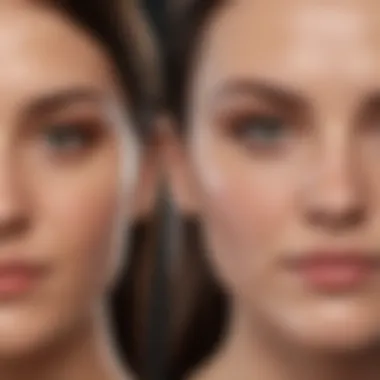Effective Strategies to Minimize Face Pores


Intro
Understanding facial pores and their appearance is crucial for anyone invested in skincare. Pores can be influenced by several factors, including genetics, environmental conditions, and personal habits. With advances in skincare, many solutions are available to reduce the visibility of pores.
The approach to minimizing pores can be broken down into various strategies, incorporating lifestyle changes, topical treatments, and even dermatological procedures. These different layers provide a continuous loop toward achieving smooth skin while promoting overall health.
Skincare Practices
Effective skincare is foundational in reducing pore appearance. Daily cleansing is vital to remove dirt, oil, and makeup, preventing blockages. This often boils down to choosing the right cleaners, like salicylic acid or glycolic acid-based products, which helps exfoliate and purify the skin.
Exfoliation
Regular exfoliation should not be ignored. It helps to skin's texture and clears dead cells that might block pores. Here are main exfoliation methods:
- Chemical exfoliants: These include acids like AHAs and BHAs, which penetrate the skin and dissolve dead skin cells.
- Physical exfoliants: These are scrubs that work manually to slough off dead skin.
Always be gentle during this process; over-exfoliating can lead to irritation and make the situation worse.
Moisturizing
Many hesitate to moisturize, fearing that it may exacerbate their pore concerns. In reality, using a non-comedogenic moisturizer is essential. This means selecting a product formulated not to clog pores or cause breakouts. Hydration leads to smooth and healthy skin, reducing the visibility of uneven textures.
Sun Protection
Don't forget sun protection. UV damage can cause skin aging and larger pores. Using a daily sunscreen helps protect your skin from harmful rays and prevents the expansion of pores over time.
Topical Treatments
Incorporating specific products can accelerate the process of minimizing pore size. Several topical treatments could be beneficial.
- Retinoids: These encourage cell turnover and can help reduce the size of pores with extended regular use.
- Niacinamide: Known for its soothing properties, it also helps to reduce sebaceous gland activity, reducing oil build-up.
- Clay masks: Utilizing clay masks weekly can detoxify and absorb excess oil.
Each of these treatments adds unique advantages to achieving a smoother skin tone.
Lifestyle Considerations
Pore size can reflect one's overall health. Thus, certain lifestyle choices play a significant role. Improving diet can lead to better skin. Seek fruits, vegetables, and water-rich foods while minimizing sugar intake, which may influence oil production. Prioritizing sleep and reducing stress also promote better skin outcomes.
Moreover, effective regular exercise leads to better circulation, fostering a healthier appearance overall.
#Talk to a Dermatologist
When at home solutions seem not to enought, consulting a dermatologist is worth consideration. Professionals like these can provide treatments, including laser therapies or microdermabrasion, designed to visibly shrink pores and improve skin text.
Remember that while pores are a natural part of skin, their appearance can adapt with careful attention and thoughtful care.
Understanding Facial Pores
Understanding facial pores is vital for anyone striving for a refined complexion, yet many neglect this foundational aspect of skincare. Pores, the tiny openings on our skin, exist for several reasons and can significantly impact how our skin appears. Knowledge of pores provides clearer insights into choosing effective products and realizing why certain methods are crucial in reducing their visibility. In this section, we’ll explore the basic nature and function of pores, followed by the reasons behind their enlargement. Such understanding is necessary for an effective approach towards achieving skin that feels and looks smoother.
What are Facial Pores?
Facial pores are small openings in the skin that allow for the secretion of sweat and oils. They are part of hair follicles and are found across the surface of the skin. Many might observe them as tiny dots, especially in areas where there are a high concentration of sebaceous glands like the nose and forehead. Fully functional pores execute pivotal tasks in skin health, helping to keep it moisturized and allowing toxins to exit the body.
The Function of Pores
Pores play essential roles beyond being a mere part of anatomical aesthetics. Primarily, they serve as gateways for natural oils known as sebum, created by sebaceous glands. This sebum keeps the skin hydrated, creating a barrier that protects against environmental irritants and pathogens. In addition, the regulation of body temperature ties into pore function, enabling sweat to escape through these openings, thus assisting in thermoregulation. A well-functioning pore system leads to balanced skin health, facilitating necessary oil delivery while helping to eliminate unnecessary elements.
Causes of Enlarged Pores
Enlarged pores can be frustrating. There are several critical factors contributing to this condition, each interacting with skin structure and biology closely. Recognizing these causes offers clarity in seeking targeted solutions. Some significant contributors include:
Genetics
Genetics plays a visible role in determining the size and overall appearance of one’s pores. Certain individuals are simply predisposed to larger pores as a hereditary characteristic. This can be due to the skin's structure, pore elasticity, or the activity level of sebum production, which can also run in families. Embracing one’s genetic makeup might not provide immediate solutions but suggests tailored approaches when considering skincare regimens that can help minimize appearance, for instance, opting for matte products.
Skin Type


The skin type another crucial aspect influencing pore size includes classified categories like oily, dry, and combination. Oily skin tends to produce more sebum, which can lead to larger pores. In contrast, dry skin types may have smaller pores due to lower oil production. It's essential to identify one's skin type to cultivate a skincare routine supportive of intricate needs. This recognition is beneficial for selecting products promising better pore appearance and overall skin balance.
Age
As individuals age, skin undergoes significant changes, necessitating further attention to pore appearance. Decreased skin elasticity and lower collagen levels cause pores to become more visible. Shifts in the supporting tissue can create hollow regions around pores, drawing attention to their size. Acknowledging age-related factors can steer one toward age-specific treatments intended to preserve skin texture better, directly benefiting pore minimization efforts.
Sun Damage
Sun exposure can wreak havoc on the skin, leading to damage that enlarges pores. Ultraviolet (UV) rays break down collagen, resulting in loss of elasticity and resulting in more noticeable pores. This issue often exacerbates over time if adequate protection isn’t applied. SEO remains imperative for skin preservation. Always integrate a sunscreen into a skincare routine to mitigate unwanted sun damage while supporting improved skin health overall.
Sebum Production
Sebum production stands out as a core chemical reaction affecting pore size. Overactive sebaceous glands lead to excess oil on the skin's surface, contributing to pore obstruction, thus making them look larger. Recognizing one’s sebum levels can assist in prioritizing regulating products or treatments. Identifying appropriate balance can promote smaller pores ultimately resulting in refined skin.
Skincare Routine for Pore Minimization
A dedicated skincare routine plays a crucial role in minimizing the appearance of facial pores. This section highlights key aspects integral to maintaining smoother skin. Proper skincare can help regulate oil production, remove congestion, and promote a fresh look. Integrating a systematic approach can not only improve your skin's health but also contribute to the overall reduction of pore size. It's essential to follow an ordered routine daily for best results.
Cleansing
Cleansing serves as the foundation of any skincare regimen. It removes dirt, makeup, and impurities that can clog pores.
Choosing the Right Cleanser
Selecting the appropriate cleanser hinges on understanding one's skin type. For oily and acne-prone skin, foaming or gel cleansers with ingredients like salicylic acid are often effective. They help in dissolving excess oil and preventing breakouts, contributing directly to reduced pore visibility.
On the other side, cream or lotion-based cleansers may be better suited for dry or sensitive skin, as they are gentler on the skin. A well-chosen cleanser can aid skin’s natural barrier, enhancing hydration and minimizing the appearance of pores. However, it is vital to avoid harsh cleansers which can irritate the skin and lead to increased sebum production.
Frequency of Cleansing
The frequency of cleansing holds equal importance in a restorative skincare routine. Generally, cleansing twice daily—once in the morning and once before bed—is recommended. This helps to remove accumulations from the day, like dirt, sunscreen, and makeup. Timely cleansing ensures the skin remains clear while preventing pore blockages.
Exceeding the advised frequency might lead to over-drying the skin, which can trigger excess oil production. The goal is to maintain a balance whereby the skin feels clean yet is not stripped of natural moisture.
Exfoliation
Exfoliation elevates the cleansing process. It promotes the shedding of dead skin cells and enhances the overall appearance of the skin.
Physical vs.
Chemical Exfoliants
Exfoliants are broadly classified into physical and chemical types. Physical exfoliants manually remove dead skin, usually via scrubs containing small particles. While they offer immediate gratification, they can sometimes cause micro-tears in the skin. This approach should be used carefully to avoid irritation.
Chemical exfoliants include ingredients like alpha hydroxy acids (AHAs) and beta hydroxy acids (BHAs). They penetrate the skin and dissolve the bonds between dead cells. Chemical exfoliants could be more effective in giving a smoother appearance with less potential for damage. They are often more beneficial for those looking to achieve nuanced improvements over time.
Exfoliation Frequency
Considering how often to exfoliate takes into account individual skin tolerance and type. Typically, exfoliating once or twice a week is deemed appropriate, especially for sensitive or dry skin. Factors such as hormonal changes, seasonal shifts, or exposure to heavy products may necessitate adjustments in this frequency. Finding the right balance can optimize skin health and ensure pore minimization.
Moisturizing
Hydrating the skin is equally significant after cleansing and exfoliating for comprehensive skincare.
Hydrating Ingredients
Incorporating products rich in hyaluronic acid, glycerin, or squalane can significantly impact hydration. Ingredients like these help to attract moisture to the skin, thereby fortifying its barrier and reducing the likelihood of pores becoming more pronounced.
Favoring a moisturizer specifically formulated for your skin type supports this approach. A suitable moisturizer not only hydrates but also promotes overall skin health, keeping pores looking smaller and less visible over time.
Non-Comedogenic Options
Opting for non-comedogenic moisturizing products is crucial, especially for referring to those with oily or acne-prone skin. These products are specifically designed to not clog pores. Products containing non-comedogenic provisions can balance hydration without exacerbating pore size. Thus, selecting the right moisturizer can be instrumental in a regimen aimed at minimizing pores.
In summation, following a thoughtful skincare routine encompassing effective cleansing, appropriate exfoliation, and proper moisturizing can greatly influence the appearance and size of facial pores. Consistency integrated with informed product choices is fundamental in achieving the desired results.
Topical Treatments for Pore Reduction
Topical treatments play a crucial role in minimizing the appearance of facial pores. Addressing this concern can significantly improve one’s overall skin texture and health. Such treatments include ingredients that target sebum production, exfoliation, and skin cell turnover. The right topical treatments not only make pores less visible but also promote smooth, radiant skin. This section covers popular active ingredients and methods for pore reduction.


Retinoids
Retinoids, derived from vitamin A, are famous in the skincare world for their effectiveness. They enhance skin cell turnover, which helps keep pores clear of debris and excess sebum. This consistent renewal can lessen the prominence of enlarged pores. However, it's essential to note the potential for irritate initially. Individuals may experience redness or dryness during the initial weeks of using retinoids.
To incorporate retinoids effectively into a skincare routine, it’s best to start with a low concentration and gradually increase usage. This approach minimizes side effects while helping the skin adjust to the new ingredient.
Salicylic Acid
Salicylic acid warrants attention, particularly for those with oily skin. As a beta-hydroxy acid, it penetrates deeply into the pores, capable of dissolving excess oil and debris. This depth of action not only aids in unclogging pores, but also minimizes the chances of future blockages.
Regular use of salicylic acid can help control acne breakouts commonly associated with larger pores. It is advisable to use salicylic-containing cleansers or spot treatments to best experience its benefits—however, sensitivity concerns may arise for some skin types.
Niacinamide
Niacinamide, or vitamin B3, is gaining traction as a powerhouse for pore tightening. This active ingredient deals with excess oil production while simultaneously promoting a more even skin tone. Using niacinamide can yield notable results in the reduction of visible pore size and is generally well tolerated by most skin. This versatility makes it suitable for various skin types, including sensitive skin.
Some products may have niacinamide as a key ingredient; applying these serums or moisturizers can enhance the texture of the skin and help in making pores less noticeable over time.
Clay Masks
Incorporating clay masks into a skincare regimen provides a unique approach for pore reduction. Clays such as kaolin and bentonite effectively absorb excess oil and draw out impurities from the skin. They provide a physical means of exfoliation, helping to unclog pores and remove dead skin cell buildup.
Using clay masks regularly can lead to improved skin clarity and freshness. Following cloudy-clay masking sessions, hydration replenishment is crucial to prevent any unwanted dryness or irritation.
Lifestyle Factors Influencing Pore Size
Understanding lifestyle factors that influence pore size is essential for those looking to minimize the appearance of facial pores. The condition of your skin does not purely stem from products used but is also affected by everyday choices regarding diet, sun exposure, and stress management. In this section, we shall explore each of these factors in detail, outlining how they contribute to pore health and skin texture, offering guides for positive change.
Diet and Nutrition
Hydration
Adequate hydration is a key aspect of maintaining skin elasticity and health. Water consumption helps to keep skin cells plump and function effectively. Often overlooked, healthy skin relies significantly on hydration. Indications of proper hydration include elasticity in skin and an overall healthy appearance. The unique feature of good hydration is its direct impact on how your skin looks. Since cells require water to transport nutrients and toxin removal, a deficiency can lead to issues such as visible pores and an uneven skin tone.
Antioxidant-rich Foods
Incorporating antioxidant-rich foods can be beneficial in supporting skin health. Foods high in antioxidants include berries, leafy greens, and nuts. This characteristic helps reduce oxidative stress on cells, which can lead to enlarged pores. Antioxidant-rich foods protect skin from damage that contributes to structural breakdown. Their unique advantages include enhancing the health of your skin barrier and preventing premature aging. Therefore, they are a popular choice for improving pore appearance.
Sun Protection
Sunscreens
Using sunscreens daily is crucial to prevent sun damage, which is a major factor in pore enlargement. Sunscreens offer vital protection against UV rays that break down collagen and elastin, contributing to larger-looking pores as skin ages. Key characteristics of sunscreens include their variety of formulations: mineral, chemical, or combination types. The unique aspect of sunscreens is their ability to provide a barrier that helps maintain skin integrity. A disadvantage can be user compliance; many individuals forget to apply it consistently.
Wearable Protection
In addition to using creams, wearable sun protection—like hats and UV-blocking clothing—serve as an extra defense against tissue damage from the sun. The essential aspect of wearable protection is its ease of use and capability to shield skin from harmful rays all day long. Many people find this beneficial as it provides non-chemical protection. Understanding its unique feature lies in the long-lasting protection it offers without the costs of reapplication. However, its effectiveness is dependent on thoughtful use and adherence to usage guidelines.
Reducing Stress
Mindfulness Practices
Recognizing mindfulness practices as a means to reduce stress can appear less obvious but this approach is important. Stress can impede skin function and contribute to an increase in pore size and breakouts. Regular practices such as meditation or deep-breathing techniques can cultivate inner calm. Notable aspects of mindfulness practices include promoting relaxation and improved skin health holistically. Their unique feature is the combination of mental health with skincare practice, although they require consistent dedication to see benefits reflected in skin appearance.
Regular Exercise
Regular exercise not only improves circulation but also helps alleviate stress levels. Routine aerobic activities can enhance blood flow, delivering oxygen and nutrients to the skin, thus supporting a healthier complexion. A key characteristic of regular exercise is its role in managing stress, which in turn detracts from enlarged pores. The unique benefit here lies in the way physical activity releases endorphins that contribute to a healthier skin tone, although time constraints may restrict a regular exercise regimen.
Maintaining a healthy lifestyle encompasses diet, sun protection, and mental well-being, all fundamental in optimizing skin quality and destabilizing enlarged pores.
By addressing these lifestyle factors, you can make substantial strides towards achieving smoother, healthier skin, effectively mitigating the appearance of pores.
Dermatological Procedures
Dermatological procedures are advanced techniques that can effectively address enlarged facial pores. These methods are essential for those who seek substantial changes beyond basic skincare routines. The effectiveness of these procedures often leads to more pronounced improvements than topical solutions. For many, incorporating dermatological interventions is a logical step to achieving smoother, healthier skin.
Several treatments fall within this category, each offering unique benefits and considerations. Selecting the right procedure involves understanding individual skin conditions and needs. Consulting with a qualified dermatologist is crucial, as they can recommend appropriate options based on skin types and concerns.
Important: Always consult with a dermatologist before deciding on a procedure. This ensures safety and that the approach aligns with personal skin needs.


Chemical Peels
Chemical peels are designed to remove dead skin layers, thus improving texture and firmness. They involve applying a chemical solution to the skin. The depth of penetration varies, suitable for light, moderate, or deep resurfacing.
Benefits of Chemical Peels:
- Reduce the appearance of pores
- Improve uneven skin tone
- Enhance overall skin texture
However, not all skin types respond similarly; some might experience peeling or redness post-treatment. Regular treatments may be necessary for optimal results. Mild peels can be done regularly, while deeper ones require longer intervals for skin recovery.
Microdermabrasion
Microdermabrasion aims to gently exfoliate the outer layer of dead skin cells, promoting the growth of new skin. It utilizes tiny crystals to buff against the skin's surface, which can diminish the appearance of pores.
Considerations for Microdermabrasion:
- Non-invasive and offers immediate results
- Minimal recovery time required
- Suitable for most skin types
While microdermabrasion can noticeably improve texture and glow, the results are generally subtle compared to other options. This should be viewed as part of a broader skincare routine for lasting benefits.
Laser Treatments
Laser treatments utilize concentrated light energy to target specific layers of the skin. This method can effectively stimulate collagen production, tightening the skin and minimizing pore size over time. Different types of lasers, including ablative and non-ablative, present varying degrees of invasiveness and effectiveness.
Key Advantages of Laser Treatments:
- Minimally invasive with swift recovery
- Rid of pigment and dark spots
- Rejuvenate overall skin quality
Laser treatments generally require a series of sessions to achieve best results. Despite their effectiveness, they may not be suitable for all skin types, specifically those with sensitivities or complex conditions.
Microneedling
Microneedling uses tiny needles to create micro-injuries in the skin, which prompts the body’s healing response. This not only aids in reducing the appearance of pores but also stimulates collagen and elastin production.
Pros of Microneedling:
- Improves skin texture and tightness
- Enhances absorption of topical treatments post-procedure
- Minimal downtime
People with various skin concerns and needs can benefit from microneedling, though it typically counts as an initial investment with cumulative long-term benefits. Patients might need multiple sessions spaced apart for significant improvements.
Ultimately, dermatological procedures play a vital role in enhancing skin complexion and reducing pore visibility. They provide optimal results when combined with a consistent skincare routine at home.
Maintaining Results
Maintaining results in pore minimization is crucial for achieving long-lasting skin health. Enlarged pores can easily return if adequate care is not continued. Often, people may observe initial improvements but underestimate the effort needed to sustain these results. Thus, embedding effective practices into your routine contributes significantly to enhancing and prolonging your skin's appearance.
A critical element of maintaining success involves establishing consistency in skincare practices. Another significant aspect to consider is scheduling regular dermatologist check-ups.
Consistency in Skincare
Consistency in a skincare routine serves as a foundation for minimizing pore size. It involves engaging with daily practices essential for skin health. A lack of routine may lead to regrowth of sebum, dirt, and debris within the pores, which can result in their enlargement over time. Therefore, engaging in activities such as cleansing, exfoliating, and moisturizing regularly can help in maintaining smaller pores.
To ensure effectiveness:
- Use cleansers formulated to balance and remove impurities without over-drying.
- Exhibit caution with exfoliants; aim for two to three times a week for effective turnover without redundancy.
- Prioritize moisturizers with non-comedogenic properties to avoid breakouts.
The question arises: how might one ensure this adherence? It may entail organizing reminders on calendars or associating skincare tasks with daily activities, like washing the face immediately after work or before bedtime.
Regular Dermatologist Check-ups
Regular dermatologist check-ups play an invaluable role in continuous skin management. It is necessary to have professionals monitoring skin health and offering tailored advice. A dermatologist can provide a comprehensive analysis based on evolving skin conditions especially associated with aging, hormonal changes, or environmental effects.
During appointments, your doctor may suggest different treatment options that you might not be aware of or may adjust your existing routines based on your current skin needs. Consistent check-ups also allow for early detection of new skin issues, such as acne or pigmentation changes, ultimately leading to better management.
In summary, successful maintenance of results in minimizing facial pores relies heavily on displaying consistent skincare habits and seeking professional guidance through regular dermatologist visits. These efforts not only nurture the skin but empower individuals in their approach to holistic skin health, sustaining the benefits derived from previous antithetic measures.
End
The importance of understanding how to minimize facial pores lies in its profound impact on skin health and appearance. Facial pores are not merely aesthetic concern; they play critical roles in our epidermis. Adequately addressing pore size can lead to smoother skin texture and an all-around healthier visage.
Several elements highlight the significance of this topic:
- Knowledge of Underlying Causes: Knowing why pores enlarge is crucial. This awareness can help individuals tailor their skincare routines specific to their skin types and conditions. Factors such as sun damage and genetics can be managed effectively with the right strategies.
- Impact on Skincare Regimens: By integrating targeted treatments, the likelihood of achieving desired results improves significantly. This guide emphasizes focus areas, from topical treatments like retinoids to ever-important moisturization techniques that influence pore appearance directly.
- Long-term Benefits: The steps to minimizing pores are not only about immediate concerns but also the long-term health of the skin. Engaging in consistent skincare and embracing medical treatments can prolong positive results.
- Lifestyle Modifications: Emphasizing stress reduction and proper nutrition reveals the holistic approach required for optimal skin health. It aligns behavioral changes with physiological benefits, showcasing that internal wellbeing reflects on external appearance.
- Scheduled Professional Care: Regular check-ups can detect potential issues before they compound. This culminates in a more proactive rather than reactive approach to skincare.
By understanding and implementing strategies to address the size of facial pores, one takes a significant step towards enhancing not only appearance but also maintaining better skin health overall.



